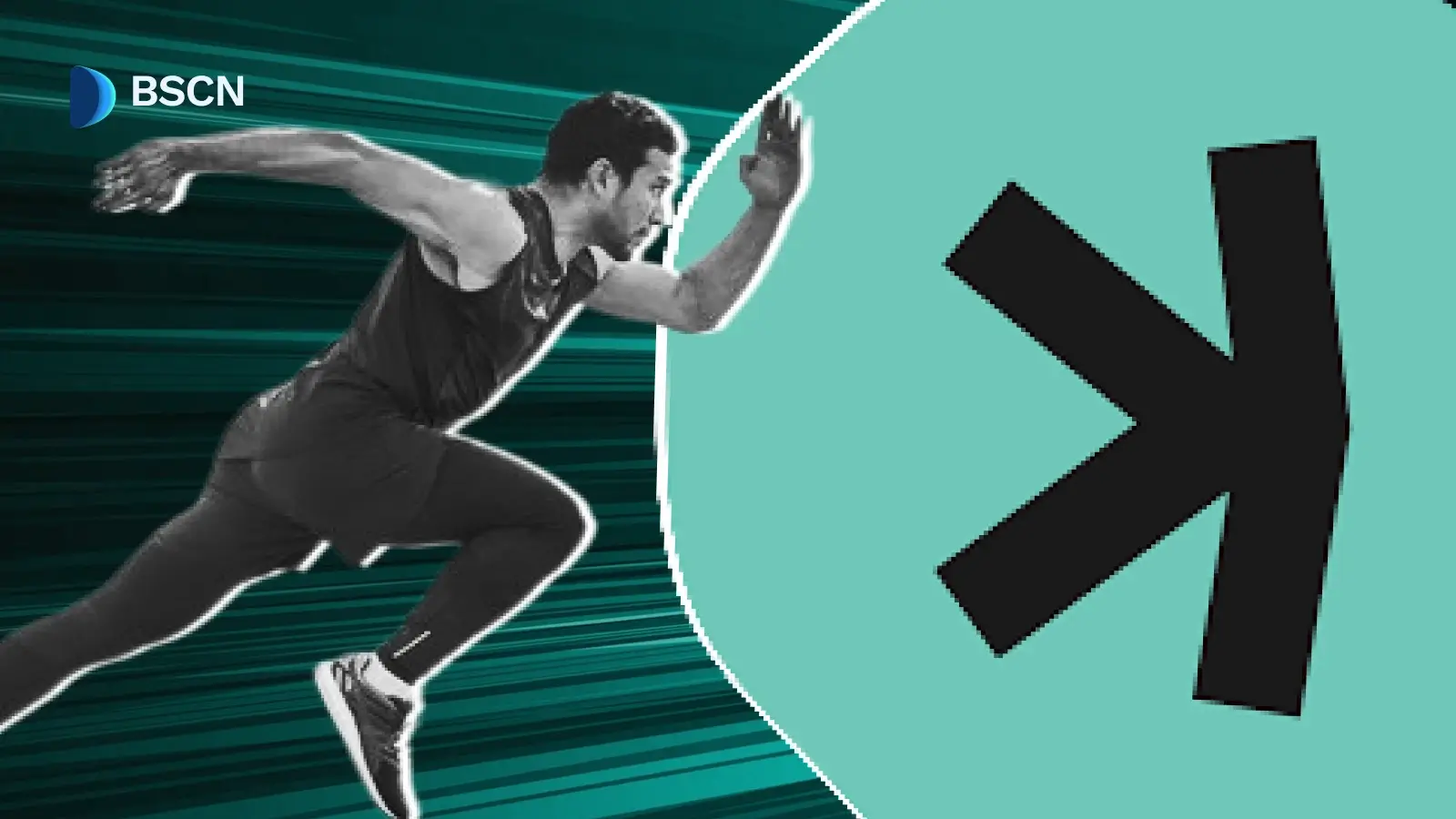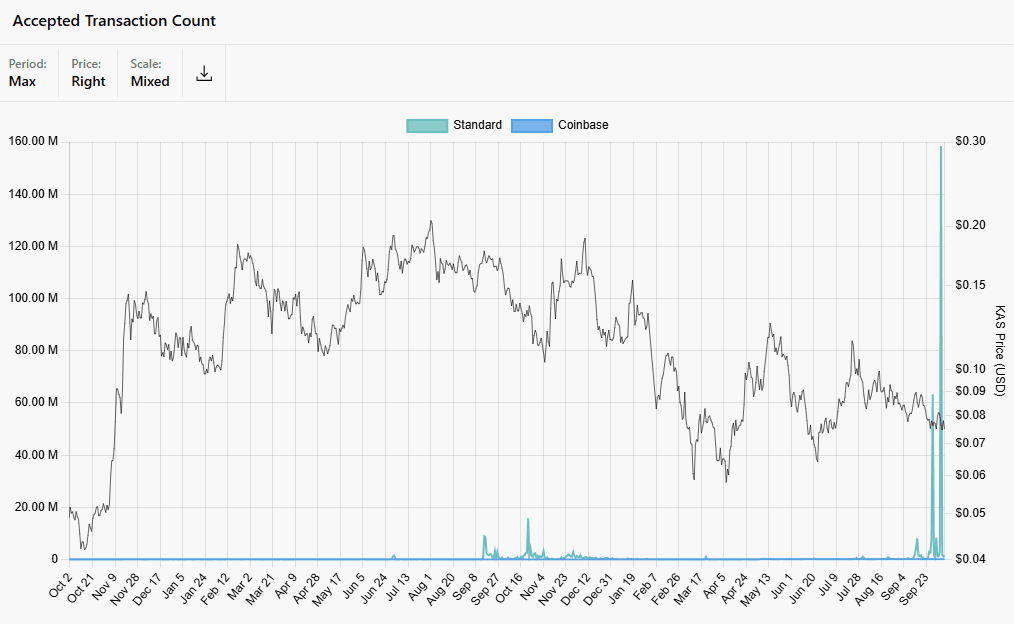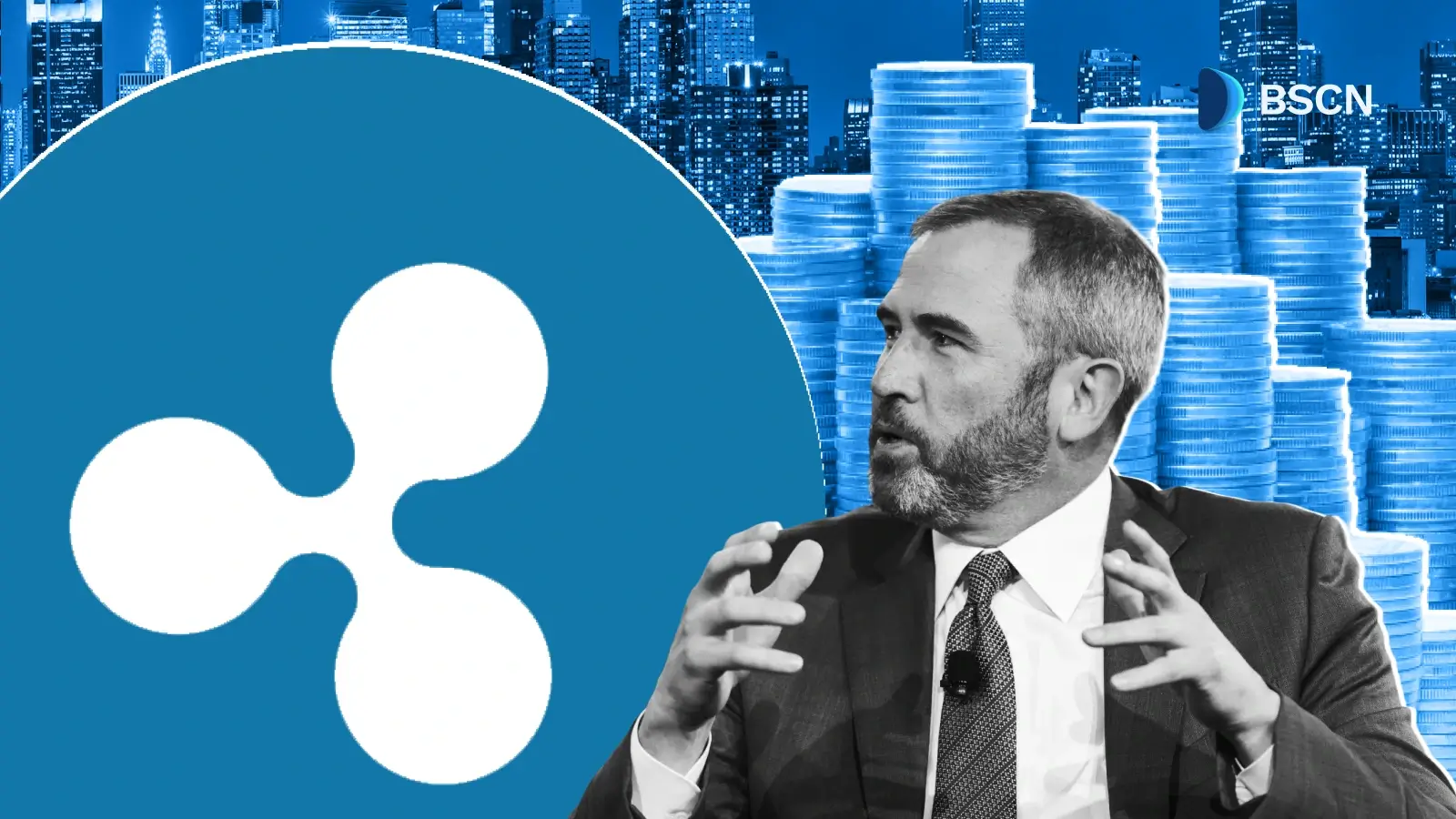News
Kaspa Daily Transactions Surpass 150M, Nearly Matching Bitcoin’s Yearly Total
by Soumen Datta
October 9, 2025

Kaspa network processes over 158 million daily transactions, setting a record for Proof-of-Work blockchains and nearing Bitcoin’s annual total.
Kaspa processed more than 158 million transactions on October 5, 2025 — nearly equaling Bitcoin’s total transactions for the entire previous year. According to data from YCharts and Glassnode, Bitcoin handled about 160 million transactions between October 2024 and October 2025.
Scalable PoW • Layer 1 • Peer-to-Peer.
— The 𐤊aspa Leidy (@kaspaleidy) October 8, 2025
—“Satoshi would be Proud of what Kas is accomplishing.”$kas #kaspa pic.twitter.com/1JO61VAhSp
This makes Kaspa the fastest-growing Proof-of-Work (PoW) blockchain in terms of daily throughput. The milestone highlights how Kaspa’s unique blockDAG architecture and recent Crescendo upgrade have transformed its processing capacity, pushing it far ahead of other major networks like Dogecoin and Ethereum Classic.

Record Throughput and Network Activity
Kaspa’s mainnet reached a record-breaking 3,585 transactions per second (TPS) on September 17, 2025. On the same day, it processed 1.92 million transactions — its highest single-day figure to date.
Just days earlier, on September 14, network data showed:
- Transactions processed: 1,918,960
- Day-over-day growth: 134% increase from 821,000
- Active addresses: More than 500,000
These numbers put Kaspa well ahead of Dogecoin (75,000 transactions) and Ethereum Classic (24,000 transactions) while staying competitive with Ethereum’s 1.63 million daily mainnet transactions. Ethereum’s Layer 2 networks such as Base added further activity, but Kaspa’s direct mainnet performance stood out among PoW chains.
Transaction costs on Kaspa remained below $0.001 per transaction — a stark contrast to Ethereum’s average of $0.47. The low fees make Kaspa ideal for both high-frequency transfers and small payments.
BlockDAG Design and the Crescendo Upgrade
Kaspa’s transaction surge stems from its blockDAG (Directed Acyclic Graph) structure — a design that allows multiple blocks to be processed simultaneously. Unlike Bitcoin or Ethereum, which follow a linear chain where only one block can be added at a time, Kaspa’s blockDAG architecture supports parallel block creation.
On September 14, Kaspa processed approximately 1.4 million parallel blocks — a remarkable figure compared to Bitcoin’s cumulative 914,695 blocks since its launch. Following the Crescendo hardfork earlier in 2025, Kaspa’s block rate increased from one block per second to ten blocks per second, drastically boosting throughput.
Transactions reach finality within seconds, because Kaspa’s protocol uses topological sorting to quickly order and validate blocks. This makes Kaspa one of the most efficient PoW networks currently in operation.
Kaspa remains a Proof-of-Work network, securing transactions through the kHeavyHash algorithm. This algorithm is optimized for energy efficiency and resists memory-bound attacks, keeping the network decentralized and secure.
New Developments
vProgs and File Storage
Kaspa continues to evolve its technical ecosystem. On September 11, 2025, it released the first draft of the vProgs Yellow Paper, introducing verifiable programs (vProgs). These allow off-chain computations to be verified using zero-knowledge (ZK) proofs and then anchored to Kaspa’s Layer 1.
Core Features of vProgs:
- Proof Stitching: Combines multiple proofs into one submission to the base layer.
- Conditional Batches: Groups related transactions to reduce proving costs.
- Computation DAG: Tracks dependencies to prevent resource overload.
- Resource Metering: Introduces a Layer 2 gas model with ScopeGas for cross-app operations.
- Privacy: Enables encrypted states and confidential apps via ZK proofs.
This framework aims to support scalable decentralized applications without compromising Kaspa’s block production speed.
Another notable addition is Kaspa File Storage, a service allowing users to upload and store encrypted files directly on the blockchain. The service operates on Kaspa Layer 1 and uses transaction payloads for file data.
Key Details:
- Upload fees are paid as miner rewards; downloading is free.
- Files can be accessed from the Archive node or via API endpoints.
- Supports directories, encryption, and real-time monitoring through WebSocket.
However, Kaspa developers have issued a security notice stating that the service has not undergone formal audits. Users are advised to connect with wallets holding only small balances when testing the system.
Quantum-Resistant Wallet Proposal
Kaspa’s development community is also exploring quantum-resistant features to secure future transactions. A developer known as bitcoinSG proposed a wallet-layer upgrade designed to mitigate threats from quantum computing, which could one day break elliptic curve cryptography (ECC).
The proposal recommends transitioning from the current Pay-to-Public-Key (P2PK) format to a P2PKH-Blake2b-256-via-P2SH address structure. This approach hides public keys until funds are spent, reducing exposure to quantum attacks.
Unlike consensus-level changes, the upgrade would be voluntary and backward-compatible. Wallets and exchanges could adopt the new format without a hard fork.
Technical Summary:
- Public key concealed until the transaction is spent.
- Blake2b-256 hashing used for enhanced security.
- Schnorr signatures required for validation.
- Compatibility maintained with existing infrastructure.
This initiative places Kaspa among the first Layer 1 blockchains to introduce practical quantum defense at the wallet level.
Conclusion
Kaspa’s transaction surge to 158 million daily operations marks a clear milestone in blockchain performance. Through its blockDAG structure, Crescendo upgrade, and efficient Proof-of-Work consensus, Kaspa has proven that high throughput and low fees are achievable within a secure decentralized network.
Its ongoing technical developments — from verifiable programs to quantum-resistant wallets — show a system focused on functionality and resilience. As Kaspa nears full supply issuance and its upcoming halving, its network performance continues to set a benchmark for scalable Proof-of-Work architecture.
Resources:
Kaspa X platform: https://x.com/kaspaunchained
Kaspa TPS data: https://www.kaspalytics.com/app/transactions/accepted/tps/max
Kaspa Technology overview: https://kaspa.org/technology/
Kaspa Explorer: https://explorer.kaspa.org/
vProgs Yellow Paper Draft v0.0.1: https://github.com/kaspanet/research/blob/main/vProgs/vProgs_yellow_paper.pdf
Bitcoin total transactions data: https://ycharts.com/indicators/bitcoin_total_transactions
Kaspa transactions data: https://www.kaspalytics.com/app/transactions/accepted/count
Disclaimer
Disclaimer: The views expressed in this article do not necessarily represent the views of BSCN. The information provided in this article is for educational and entertainment purposes only and should not be construed as investment advice, or advice of any kind. BSCN assumes no responsibility for any investment decisions made based on the information provided in this article. If you believe that the article should be amended, please reach out to the BSCN team by emailing info@bsc.news.
Author

Soumen Datta
Soumen has been a crypto researcher since 2020 and holds a master’s in Physics. His writing and research has been published by publications such as CryptoSlate and DailyCoin, as well as BSCN. His areas of focus include Bitcoin, DeFi, and high-potential altcoins like Ethereum, Solana, XRP, and Chainlink. He combines analytical depth with journalistic clarity to deliver insights for both newcomers and seasoned crypto readers.
Related News
Latest News
10h : 0m ago
Solana ETF Interest Rise amid Market Downslide: Key Performance Update

12h : 15m ago
BNB Chain × YZi Labs Local Hack Series Went Live: Details

13h : 52m ago
Stable Launches Public Testnet: Steps to Engage

15h : 0m ago
Ripple Secures $500M Strategic Investment at $40B Valuation

17h : 0m ago
SBI Digital Markets Partners with Chainlink to Drive Institutional-Grade Tokenization Platform

November 5, 2025
What is Momentum Finance? Binance’s New Listing

November 5, 2025
Chainlink Kickstarts November with Multiple Innovations: A Look at The Protocol's Key Partnerships and New Features

November 5, 2025
ION Latest Update: New Online+ Update, CEO Insights, Key Partnerships, and More

